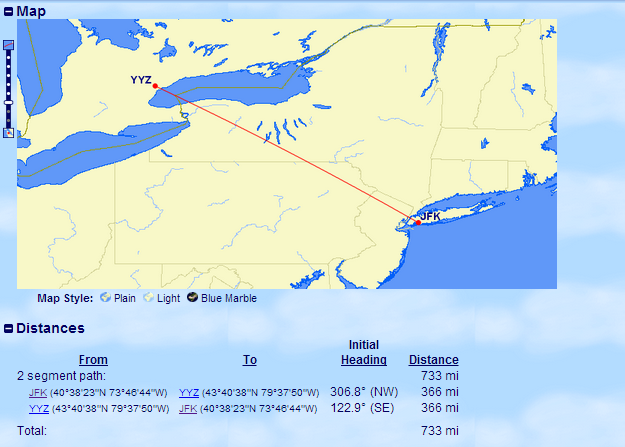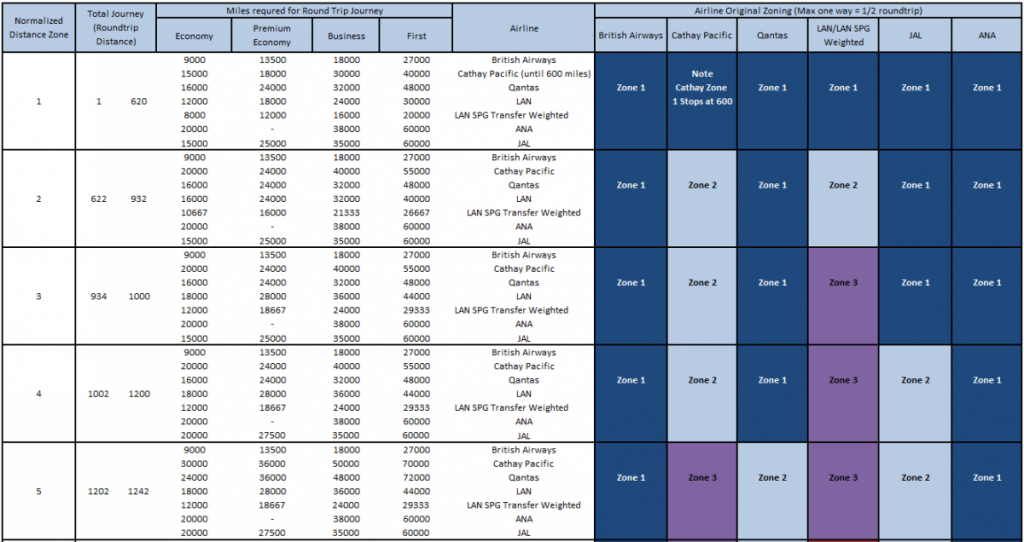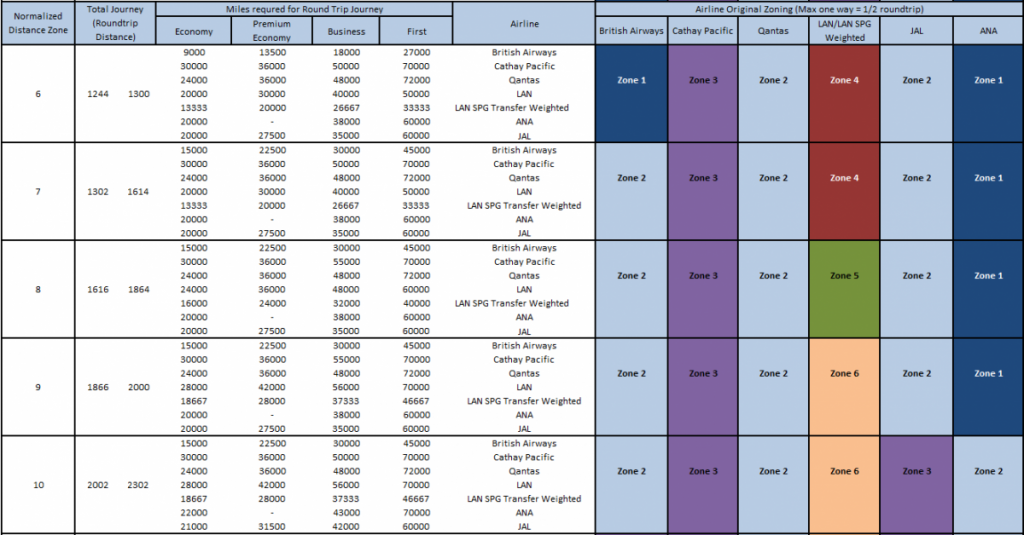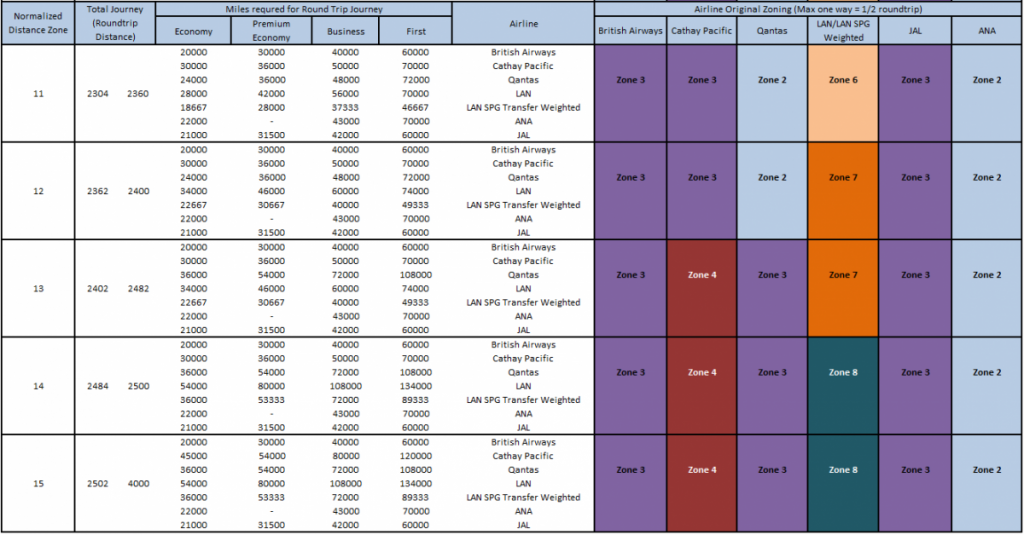Short Haul flights offer some of the very best value per mile when booked using your award travel. This post will build upon the previous Distance Based Award Travel Part 3 to include journeys of the same one way distance (up to 2000 miles in one direction, 4000 miles round-trip). Once we engage upon Round Trip reservations we open up the door to LAN, ANA and JAL airlines, as all of these will not allow you to book just a one way ticket using their mileage program rules.
When the flight is overland then flights of a short duration are often inefficient methods of travel, but they really come into their own when water is involved. for ultra short haul flights, such as island hopping in Hawaii a plane can be a real savior. The purpose of post number 4 in the series is to compare all of the options available, up to a total journey of 2,000 miles Round-trip, or 1,000 miles each way.
As we discussed earlier, there are two types of distance based award redemption available, those that calculate on a one way pricing scale, and those that calculate on a total journey pricing scale. In order to compare Round Trip flights I think it is only fair that we allow the one way pricing airlines of British Airways, Qantas to compete with the round trip players of JAL, ANA, LAN. Cathay Pacific actually has pricing options that fit into either a one way award or a round-trip award (the latter being priced up accordingly).
There are 5 Programs being compared in the below charts, and I also decided to include a further rating for LAN when you consider the SPG Transfer weighting – I believe that many people who could benefit from LAN award flights who are based in North America or Canada would acquire their points by transferring from the Starwoods SPG Program.
The Starwood SPG Amex is a great card for accessing such points. All of the points transferred from the SPG program to any airline program will gain 5K SPG points for every 20K transferred, however the LAN program also has another accelerator in that it transfers at 1:1.5 LAN points. When you consider this additional value the LAN redemption becomes much more interesting a proposition.
Understanding the Chart Below
I took all of the award programs and created award zones that would be comparable. For example, by definition British Airways does not have a travel zone that ends at 620 miles round-trip; their Zone 1 (4500 Avios points) is valid for any one way route up to 650 miles, or 1300 round trip. Therefore for each segment below I have listed the required Avios as 4500 x 2 until the Total Journey Length in column 2 exceeds 1300 round-trip miles.
The segmentation was required as each program divides its zones differently, and if you wanted to look at a route say, from New York- Toronto GCMap would list the mileage required as 733 Miles Round Trip (366 miles each way) as you can see below:

This would then lead the reader to cross check the ‘normalized zone 2 list from below (distances between 622-952) which would actually seek to compare the following for an Economy Class Fare:
- British Airways Zone 1 (upto 650 Miles each way) 4500 must be doubled for a round trip price. Total 9000 Avios
- Cathay Pacific Zone 2 (601- 1200 Miles Total Journey Length AKA Round-Trip Rate) Total 20,000 Asia Miles
- Qantas Zone 1 (upto 600 Miles each way) 16000 Qantas Miles
- LAN Zone 2 (311-466 Miles each way) 8000 each leg, doubled to 16000 LANpass Kilometers, reduced to 10667 should you be transferring from SPG
- ANA Zone 1 (upto 2,000 Miles Total Journey Length AKA Round-Trip Rate) 20,000 ANA Mileage Club Miles
- JAL Zone 1 (upto 1,000 Miles Total Journey Length AKA Round-Trip Rate) 15,000 JAL Mileage Bank Miles
Chart for Normalized Distance Zones 1-5 (up to 1242 total Round Trip Miles, not more than 621 Miles Each way)

British Airways Avios Program remains a clear leader among the players above, however for super short hops, those which fall into LAN Zone 1 distances of no more than 310 miles each way, LAN does win out slightly, should you be transferring in from the Starwood’s Amex into LANpass Kilometers.
It does also win out using the same criteria for the normalized Zone 2 First Class ticket, but for myself that ticket wouldn’t be worth booking as we are talking a flight no more than 476 Miles each way (962 total length) I personally would not seek to pay such a high multiple for an F ticket, such seats would be no more than a recliner seat for the and you might be lucky enough to knock back one free beverage before landing.
Chart for Normalized Distance Zones 6-10 (up to 2302 total Round Trip Miles, not more than 1151 Miles Each way)

This second chart (above) is a great example of highlighting how the different programs decide to segment their zones, LAN offering the narrowest bands between each zone, whereas ANA, which ranges from 1-2000 Miles Round Trip for Zone 1 travel only just enters its zone 1 pricing at the final Normalized block.
It is interesting to note that JAL only increases its Economy award rate from 20,000 points for zone 2 to 21,000 for Zone 3, which allows travel up to twice as far, that 21,000 point price travelers using a JAL award can travel distances of up to 4,000 miles Round Trip. Further to this, I noted that there appeared competition between JAL and ANA for their award pricing, which is another important factor when we look further ahead in this study. JAL (OneWorld) and ANA (Star Alliance) are Japan’s leading Carriers, so their internal Japanese competition between pricing (you will frequently see awards that are very competitively marked between the two programs) will open up award sweetspots for us further ahead.
Yet again, British Airways is the clear winner for required Frequent Flyer Miles, the notable exception occurs when they enter their Zone 2 award prices of 7500 per leg, for travel between 651-1151 Miles each way. Unusually this occurs at a junction where LAN does not change zones, and for a brief moment, within Normalized Zone 7 LAN peeks ahead (again only if you are buying into my proposition that they should be weighted to account for their comparative cheapness when transferring into either program from the SPG Card.
An example of a ticket that would slot into the Normalized Zone 7 would be JFK-BDA, which is quite topical since I just returned from Bermuda!
Chart for Normalized Distance Zones 10-15 (up to 4,000 total Round Trip Miles, not more than 2,000 Miles Each way)

In the final Chart, for journey’s that are between 2304 and 4,000 miles Round Trip yet again we see that British Airways Avios are leading the group. Rather interestingly the same anomaly occurs here when we look at the tail end LAN Zone 6 (14,000 each way miles unweighted) and British Airways Zone 3 (10,000 each way miles) in that with the 1.5 SPG ratio weighting LAN does again squeeze out BA, but only just. Not very much exciting to be found there, but it would be better to look at transferring to LAN (from a pure Frequent Flyer points perspective) than BA for flights in that narrow normalized Zone 11 between 2304 and 2360 miles Round Trip. Needless to say there aren’t going to be many flights that fit into that band!
Conclusion
Thus far it is clear that the leader is British Airways Avios for their round trip and one way flights, though already we can see the range narrowing dramatically from where they started out. The two airlines of most interest to me going forward are the Japanese players of JAL and ANA as JAL is really close to British Airways now, and it will be interesting to see how that plays out, and they are both OneWorld Carriers. ANA on the other hand is a sleeper airline here since I threw it in with the OneWorld Partners when it is a Star Alliance Airline, and as such despite a small lag in value between the charts above when you take those numbers and compare it with the award pricing within Star for their Non-Distance based award travel programs there will be value to be had.
Other Posts in the series:
- Exploring Distance Based Award Programs – Part 1 An Introduction to the airlines
- A look at Distance Based Award Travel Part 2 – Breaking down the study
- Distance Based Award Travel Part 3 Short Haul (up to 2000 Miles) One Way Options Compared
- Distance Based Award Travel Part 4 Short Haul (up to 2000 Miles Each Way) Round Trip Options Compared
- Medium Haul 2,001-6,000 Mile One Way Awards Compared
- Medium Haul 2,001-6,000 Mile Round Trip Awards Compared
- Long Haul Over 6,000 Mile One Way Awards Compared
- Long Haul Over 6,000 Mile Round Trip Awards Compared
- Long Haul Over 10,000 Mile Round Trip Awards Compared

Your methodology needs further refinement methinks. You use SPG’s 25% bonus assuming you can get that on every point (when in reality it is very limited by the 20K blocks). Additionally, since SPG is difficult to accumulate with only 1x and paltry signup bonuses, you’ve have to be an idiot to put any more than minimum spend on the card (sadly, there are LOTS of idiots).
There are significantly better cards to put spend on for airline points.
Conversely, you missed adding a weighted chart based on ability to earn points from bonus categories – likely because it becomes much more complex analysis. But it’s a glaring omission. Clearly, earning points at 2-3x is preferable than transferring 20K blocks of SPG to get 1.25x – especially if you get transfer bonuses on top.
For example, best card to earn Avios isn’t the BA card, it’s the PRG – 2x MRs on gas/grocery and 3x on airfare – and then transfer to Avios. I do a ton of MS at 2x gas/grocery and put ~$100K a year of reimbursable travel at 3x (effectively zero cost points for me). I try and wait for transfer bonuses (like the recent 35% bonus to Avios) to top up my Avios. Not only is my cpp significantly lower if I get MRs via PRG, I can also get large transfer bonuses plus can transfer instantly in only 1K blocks (making MRs inherently more flexible, and valuable). Thus I earn points faster for same dollar of spend AND at a significantly lower cpp AND with much more flexibility – a huge advantage over earning at 1-1.25x like you get with AA/SPG.
I’d much rather see a chart that shows “weighted” effect based on cpp as it has significantly more meaningful impact on what cards you put your spend on than almost any other factor. Doing so would throw most of the “analysis” of what cards/programs are “best” on their ear – that would be bad for affiliate income, so not holding my breath, lol.
If you do the math, Avios via PRG/MRs offers the single best value for airlines (with ANA not far behind) on short/mid range – but the obvious downside is routes with fuel surcharges (which I refuse to pay).
For laughs, why don’t you do the math for yourself – and see why much of what is considered gospel in this space is in reality nonsense…
Nice points, thanks for taking the time.
I might want to get into the analysis you are talking about, my plan for this series was to bring in other transfer partners later and I hadn’t thought to focus on the MR transfer route just yet.
I personally haven’t jumped on MS at 2x just for cost alone, though I am considering revisiting my approach to that. I don’t do the BB Reload MS model myself since there wasn’t any readily available over here, but that has changed.
On affiliate income, you might note that both SPG and the PRG are both issued by Amex. The latter I believe pays a larger affiliate fee and as such would easily be a bloggers ‘best’ card. I don’t have links to either at time of writing and the purpose of the post was to share ideas.
Glad you came by, you raised some interesting points and gave me good ideas for future refinement, I hope to be able to handle the added work of the cpp model.
Another wrinkle for those of us who do not live in an AA or AS hub is that the per-segment BA pricing inflates the cost. Some of the highest value redemptions are U.S.-Caribbean or U.S.-Central America, which price out at 21K or 22K JAL or ANA miles up to 4000 miles RT, but 29K or 30K using BA with a stop. Throw in the (usually) much better availability on UA metal, and ANA wins for me. For example, try MSP-ORD-CUN or YUL-(EWR/IAD/MIA)-GCM on each, rather than just NY.
Absolutely, distance based awards where you are paying per segment of the trip are inherently only appropriate for direct routes (baring some unique clean connecting routes, where each leg has a solid ‘purpose’ ) that certainly means that hubs matter a lot.